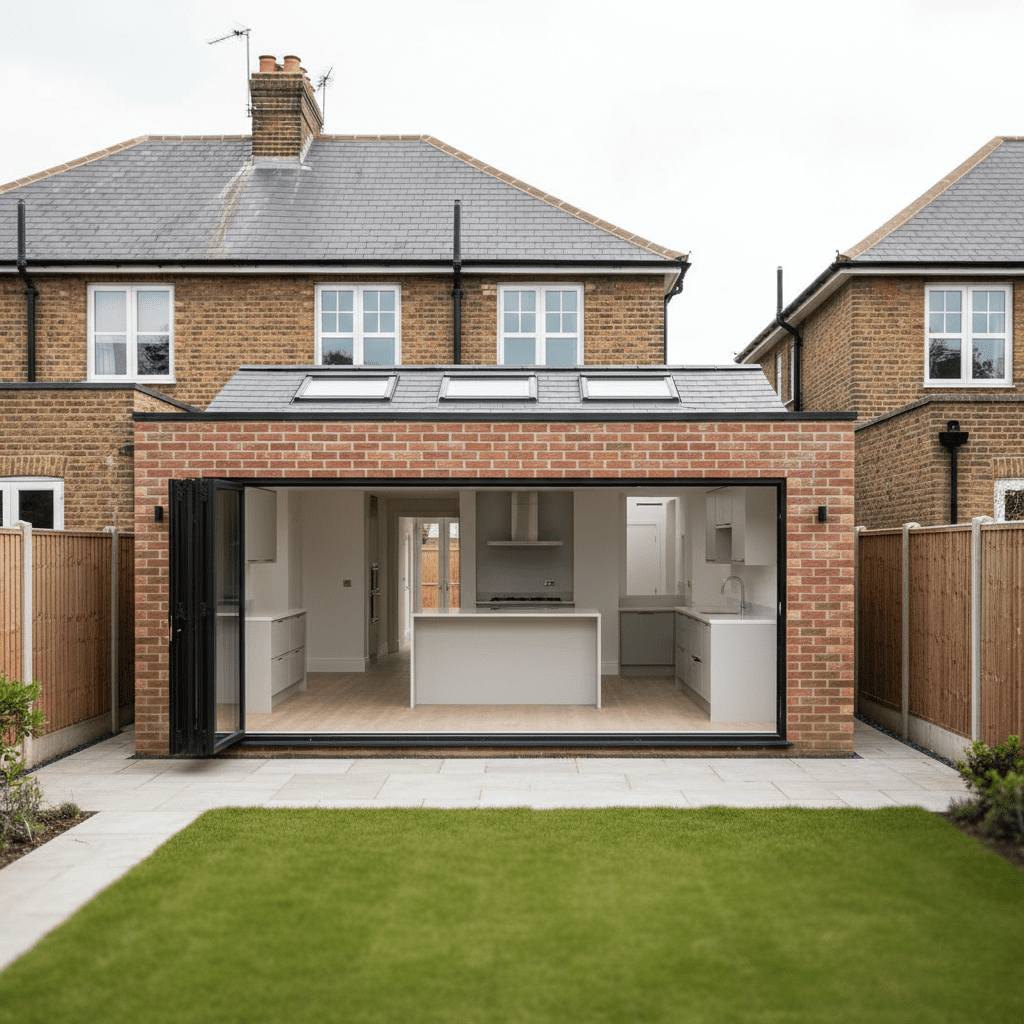
Steel Beam for Extension: A Clear Guide for UK Homeowners (2026)
A steel beam is often the main structural part of a home extension. It holds up the load when you open a wall or create a bigger space. If you are planning an extension in the UK, you will almost always need at least one steel beam for extension support. This guide explains everything in simple language so you know what your builder and engineer are talking about.
What Is a Steel Beam in an Extension?
A steel beam carries the weight of floors, walls or the roof when you change or remove a supporting wall. Builders often call it an RSJ, UB, or steel beam extension support. All three mean the same thing: a strong rolled steel section that sits above the opening.
Why steel beams are used
- They are strong and compact.
- They can span long distances.
- They keep the extension safe and stable.
Without the correct beam, the structure could sag or crack.
Types of Steel Beams Used in Home Extensions
Universal Beams (UBs)
The most common choice. Narrow and strong. Ideal for most house extensions.
Universal Columns (UCs)
Shorter and deeper. Used when the load is heavy or when the bearing area is small.
Twin beams (bolted together)
Used when one beam is not enough or when you need to reduce head height.
Flitch beams
A timber–steel–timber sandwich. Less common today but used when full steel is awkward.
When you see search terms like extension steel beam, steel beam house extension, or steel beam extension, these all refer to the same idea: a structural steel support that keeps the house safe.
When a Home Extension Needs a Steel Beam
Most extensions need one or more beams when you:
- Undertake a load bearing wall removal
- Build a large open-plan kitchen
- Add bi-fold or sliding doors
- Extend the rear or side of the house
- Add a first-floor extension above a ground-floor room
- Remove chimney breasts as part of the new layout
If the new opening is wider than 1 metre, a steel beam is almost always required.
How a Structural Engineer Designs Your Steel Beam
A structural engineer works out the beam size, loading, bearing, padstones and connections. This is needed for Building Control approval.
What the engineer checks
- Weight from walls, floors or roof
- Span length
- Type of existing construction
- Wind load or roof spread
- How the beam connects to other beams or walls
- Bearing capacity of the walls
This is where you will see terms like steel beam calculation, structural steel check, or extension beam calculation.
Why calculations matter
Without correct calculations, the beam might deflect, cracks can form, doors and windows may jam, and Building Control will not approve the job. These problems cost more to fix than getting it right at the start.
Typical Steel Beam Sizes for Extensions
Every house is different, but these are common examples builders see:
- 152×89 UB for small openings
- 178×102 UB for standard kitchen knock-throughs
- 203×133 UB for medium spans
- 254×146 UB for large openings with heavy loads
- 305×165 UB for double-storey or long spans
These are examples only. Your RSJ design must be properly calculated, not guessed.
Padstones and Bearings Explained
The steel beam needs a solid base to sit on. That base is called a bearing. A padstone spreads the load safely into the wall and down to the footings for extension stability.
Common padstone sizes
- 440×215×100 mm
- 440×215×140 mm
- Larger sizes for heavy loads
If the wall is weak or made of old brick, the engineer may specify a reinforced concrete padstone.
Beam Connections and Bolts
Sometimes two beams cross or sit on top of each other. This is common in wrap-around extensions.
Connection types
- End plates
- Web cleats
- Bolted connections
- Flitch plate bolts
A good design keeps the steel rigid and prevents twisting.
Steel Beam Costs for Home Extensions (2026)
The cost depends on the size, weight, fabrication, delivery and labour.
Cost of supply-only steel
Average 2026 UK prices:
| Span | Typical Beam Size | Cost |
|---|---|---|
| 2–3 m | Small UB | £180–£260 |
| 4–5 m | Medium UB | £260–£450 |
| 5–6 m | Heavy UB | £450–£800 |
| 6–7 m | Extra heavy UB | £800–£1,400 |
Cost of structural calculations
- One beam: £250–£350
- Multiple beams: £450–£750
- Full structural calculations pack: £650–£1,200
Extra costs to expect
- Padstones
- Fabrication plates
- Acrow props hire
- Labour for fitting
- Builder’s time
- Building Control inspections
Building Control Requirements
Building Control must approve all structural steelwork. They check:
- Beam calculations
- Correct size and grade
- Proper bearings
- Fire protection
- Stability of the overall structure
If something is missing, they can stop the job until it is fixed. For official standards, you can check the Planning Portal.
Fire protection
Steel beams must be painted with intumescent paint or wrapped in fire-rated plasterboard. This gives the beam enough time to resist fire.
Common Mistakes Builders Make
Using a guessed beam size
This is the most common problem. Guesswork can lead to failures.
No padstone
A beam on bare brick can crush the wall.
Wrong bearing length
Minimum safe bearing is normally 100 mm or more.
Cutting into joists
Joists must connect safely with joist hangers or timber plates.
No lateral restraint
Beams need restraint to stop twisting.
How to Make Your Extension Structurally Strong
A good extension follows three simple steps:
Step 1 – Hire a structural engineer
They design the beams and ensure all loads are supported. Always ensure you choose a qualified structural engineer for extension projects.
Step 2 – Let the builder follow the structural drawings
No changes should be made on site without checking.
Step 3 – Get Building Control sign-off
This protects you if you sell your home later.
FAQ About Steel Beams for Extensions
Do I need a steel beam for every wall I remove?
If the wall is load bearing, yes. A structural engineer will confirm.
How long does it take to install a beam?
Most beams take one day to install.
Can a steel beam rust?
Inside a house, rust is rare. Fire protection and plasterboard keep it dry.
Can I open two walls at once?
Yes, but you may need multiple beams or a goalpost frame.
Areas we work in
We design steel beams for extensions, wall removals and loft conversions for clients across England. If you prefer to speak to someone who knows your local area, you can start with one of our city pages:
- Structural Engineer London
- Structural Engineer Manchester
- Structural Engineer Birmingham
- Structural Engineer Bristol
- Structural Engineer Leeds
- Structural Engineer Liverpool
- Structural Engineer Nottingham
For other locations, you can also start from our main site SECalcs home page or send drawings direct through our contact form.
Conclusion
A steel beam for extension is one of the most important structural parts of any home improvement project. With the right engineer, correct beam size and proper Building Control checks, your extension will be safe, strong and long-lasting.

